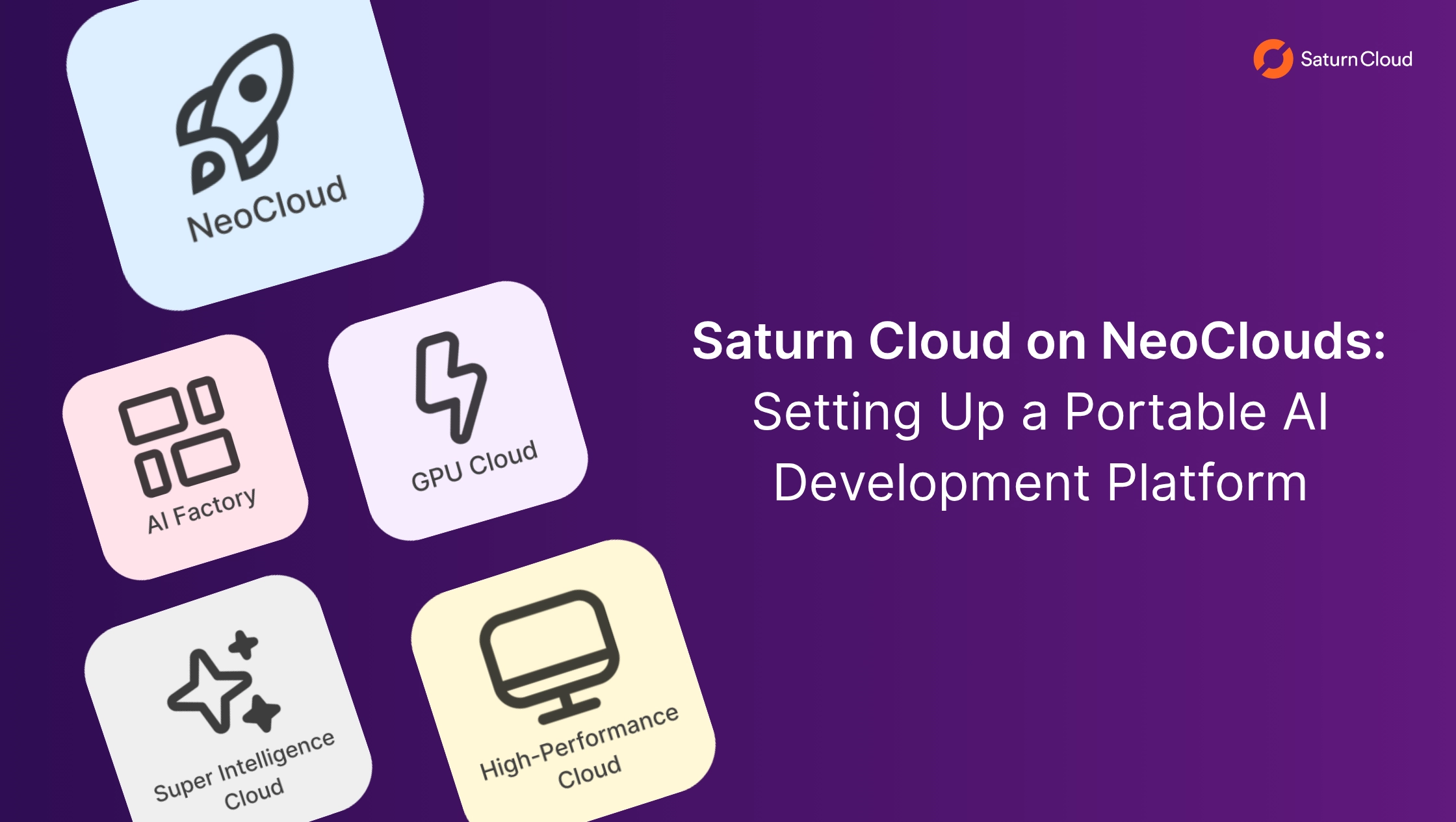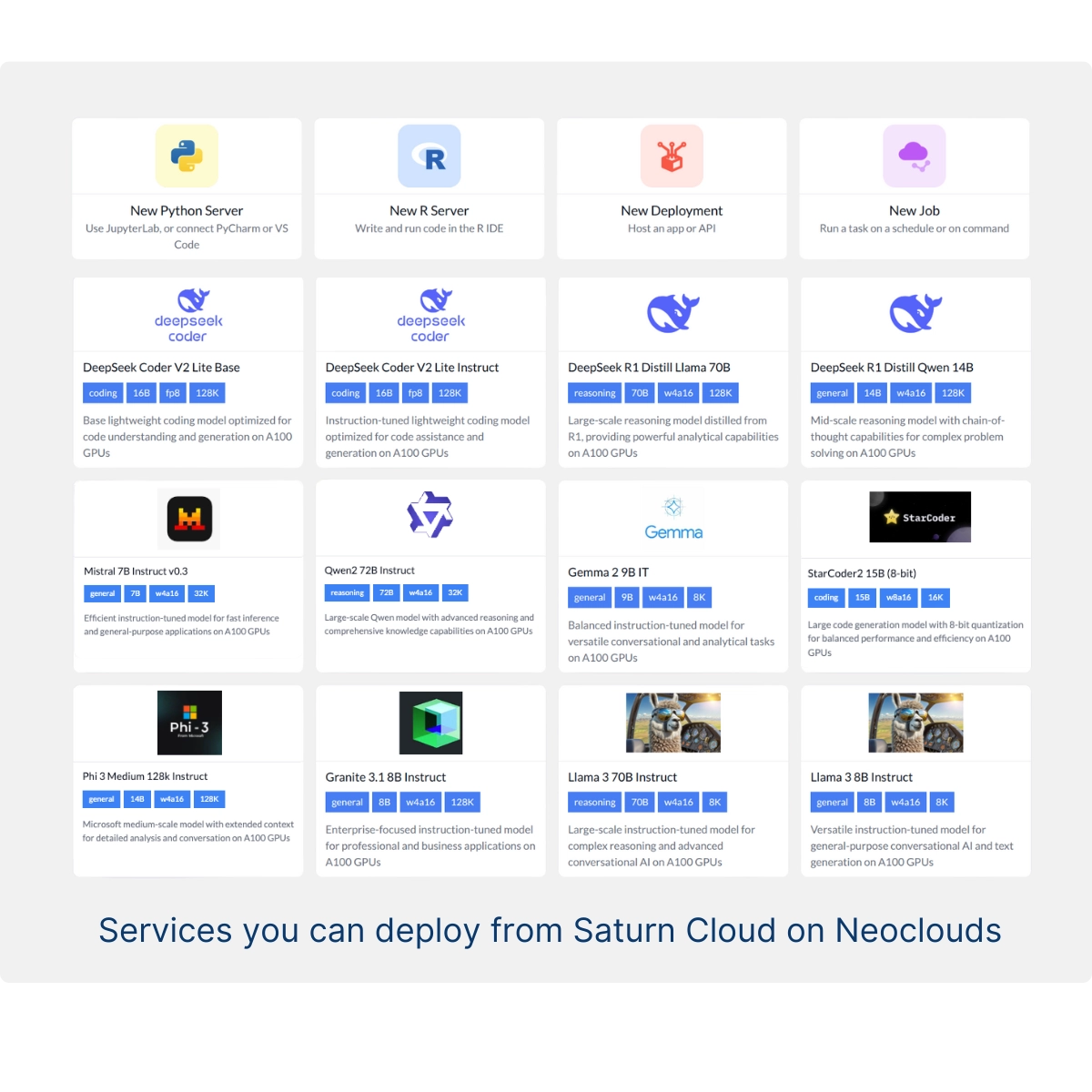Saturn Cloud on Neoclouds: Setting Up a Portable AI Development Platform

AI teams are increasingly moving to Cloud Services like Neoclouds, such as Nebius, Crusoe, and Vultr, for better GPU availability and lower costs. However, infrastructure alone doesn’t get you to production, which can mean weeks of internal platform work before ML work can begin.
Saturn Cloud bridges that gap as a single-tenant, portable AI platform that installs directly into your Neocloud account and runs on your managed Kubernetes cluster. You get enterprise-ready MLOps tooling—workspaces, scheduled jobs, model deployments, and team management—without having to build it yourself or relinquish control over your infrastructure and data.
How It Works
Saturn Cloud installs into any Kubernetes cluster in your cloud account—whether you provision it yourself or let us do it for you.
We provide Terraform modules to set up your cluster and GPU node pools
We deploy Saturn Cloud via Helm, using a bootstrap API token
We handle auth, logging, monitoring, autoscaling, and updates
Under the hood, it’s Kubernetes-native. You bring your Git repos and Docker images. Saturn Cloud turns them into running workloads—Jupyter notebooks, jobs, model endpoints, whatever you need.
What Saturn Cloud Gives You
Saturn Cloud provides AI/ML teams with everything they need to get started immediately:
Development workspaces like JupyterLab, RStudio, or VS Code via SSH
Scheduled jobs for training and inference pipelines
Deployments for models, APIs, dashboards, or LLM apps
Full support for GPUs, shared filesystems, and CI/CD integration
All without relying on internal DevOps or platform engineering teams to build custom infrastructure from scratch.
What Saturn Installs
Saturn adds a small control plane to your cluster and wires the standard pieces:
Authenticated ingress with per-project RBAC
Log collection and metrics (e.g., fluent-bit to your log store; Prometheus)
GPU enablement on designated node pools (NVIDIA GPU Operator where supported)
SSH proxy for IDE access (VS Code, PyCharm, Cursor)
Cluster autoscaler integration
Network policy via the cluster’s CNI (e.g., Cilium when available)
Control components run on a dedicated system node pool. User workloads run on CPU and GPU node pools you define. Taints and tolerations keep system components isolated from training and serving workloads.
How Engineers Use It
Saturn exposes three Kubernetes-backed resource types:
Workspaces (Deployments) JupyterLab or RStudio in the browser, or connect over SSH from your IDE. Home directories are persistent. Shared filesystems can be mounted for team data.
Jobs (Jobs/CronJobs) One-off or scheduled runs. For multi-node training, Saturn provides environment wiring, allowing launchers like torchrun to coordinate workers.
Deployments (Deployments + HTTP)
Serve LLMs, ML models, or dashboards behind authenticated endpoints. Roll forward/back by updating the image tag you control.
All resources can be created and exported as YAML recipes. Teams typically keep these in Git and have CI/CD create or update resources in Saturn alongside image builds.
Typical First Workflow
Engineers usually start by creating a Workspace from a base image (or a team image), attaching a Git repository, and working in notebooks or via SSH from a local IDE. When training is ready, they promote the code to a Job, including multi-node runs when required. Inference is packaged as a Deployment behind an authenticated endpoint. The Kubernetes resource specifications for these steps are maintained as YAML recipes in Git, and CI/CD updates them concurrently with image builds.

Installation Overview
Cluster
Use the provider’s managed Kubernetes. Create node pools for system, CPU, and GPU workloads. Configure storage classes as needed for persistent home directories and any shared filesystems.
Helm Install
Register your company with Saturn Cloud to obtain a short-lived (4-hour) bootstrap token. Install the saturn-helm-operator and pass the token. The operator:
Exchanges the bootstrap token for a long-lived token and keeps it refreshed
Creates required secrets, including TLS/SSL for ingress
Installs Saturn Cloud and supporting microservices
Post-Install
Reset the admin password, sign in, and invite users. Optionally configure SSO (SAML/OIDC). Attach your container registry and any shared filesystems you plan to use.
Workloads are standard Kubernetes objects that run your container images, with code pulled from your Git repositories. This keeps them portable and reproducible.
Security and Networking
The installation is a single-tenant account. Traffic is private by default, with public endpoints enabled only when explicitly configured and always authenticated. Secrets remain within your cluster (or are integrated with your external vault), while logs and metrics are routed to destinations you control. Access is enforced through per-project, per-resource RBAC, so teams get only the necessary permissions.
Operations and Cost Controls
Compute is organized into separate CPU and GPU pools with autoscaling applied to the pools you choose. Projects can have quotas and instance guardrails to prevent overprovisioning. Workspaces support idle suspend to reduce waste, and jobs can be scheduled to run in defined windows. When your provider offers spot/preemptible nodes, you can add a dedicated pool and opt specific workloads into it.
Get Started
You can deploy Saturn Cloud into any Neocloud account in under an hour. We handle the heavy lifting - so your team can focus on building. Reach out via chat on Saturn Cloud to learn more.
About Saturn Cloud
Saturn Cloud is a portable AI platform that installs securely in any cloud account. Build, deploy, scale and collaborate on AI/ML workloads-no long term contracts, no vendor lock-in.
Saturn Cloud provides customizable, ready-to-use cloud environments
for collaborative data teams.
Try Saturn Cloud and join thousands of users moving to the cloud without having to switch tools.



